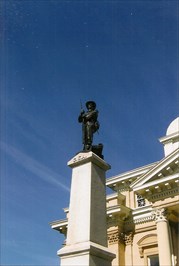
Originally published Asheboro, North Carolina, Courier-Tribune August 25, 2017
What to do with a Confederate Statue
Struggling to support her family working two menial jobs, she prays her kids stay out of trouble. There is no father to help.
The other woman has been laid off and worries about her high school drop-out daughter and opioid-addicted son.
One of them is black, the other white.
They both need our help and a strong community offering safety, opportunity, and jobs.
A statue torn down will not help one, nor will a statue staying up help the other.
An understanding of our history, where we got it right and where we got it wrong, just might help.
History is our story. It’s complicated. A human endeavor, it is a mix of triumph and failure.
Imperfect people (is there any other kind?) set out the conditions that would enable continuous improvement.
A slave owner declined to be king and insisted on two terms only. A brilliant rebel general spent the rest of his life trying to reconcile two sides. An emancipator-president had personal racial views that would be shocking by 21st century standards.
Rarely can we measure people or social contributions with a simple good-evil either/or. The usual for us mortals: “and.” Both good and evil.
Firebrands fed-up with being treated as second-class citizens by an arrogant English parliament instigated the First Civil War. Not all colonials were enthused. Many fought back and died. Many fled (or were driven) to Canada. North Carolina was a bloody mixture.
The founders tabled the slavery issue. Delicate balances assured smaller population states they wouldn’t be swallowed up in an overwhelming federal scheme. Suspicion of centralized authority ran high.
Those issues festered for a later generation. The Second Civil War.
The causes were complicated. Certainly slavery, but also the role of the federal government, the unity of the states, and tariffs.
My nonhistorian suspicion is that the planter elites depended upon a slavery-and-cotton based economy to maintain wealth, but they also needed muscle to fill out an army. How many Randolph County farm boys, if told “you probably won’t come back alive, but the Beauregard’s of Carteret County need you to fight and die to maintain their lifestyle” would jump into the volunteer line? Better to rally with, “Protect your homes and farms from northern invasion!”
I also suspect that Lincoln’s main aim was preservation of the union; abolition was an added, worthwhile, and specific cause to rally the population, as opposed to a rather gauzy “we must preserve the union.”
On either side, which framing of the issues made laying down youthful treasure more palatable?
The final tab: 650,000 or so dead, as many as 1 in 3 young men gone. In just one battle (Gettysburg) 50,000 dead.
Would we tolerate that now?
I believe there are those in our midst who would. Left or right, statue up or statue down, there are bat-and-gun wielding thugs out there that need each other for the fight they crave. These are not people interested in moving heads and hearts as much as breaking them.
I pray that we aren’t in the early stages (say, comparable to the late 1850s) of the Third Civil War. The common ground of consensus, where rest those universal concepts that constitute good and evil, virtue and sin, shrinks daily.
We think less of a big social compact and building a better society, and more of “what is in it for me and mine, here and now.”
Meanwhile neo-Nazis and neo-Marxists lust for blood.
So here’s a modest proposal that might work for Randolph County.
A bronze Confederate (he’s no general) guards the front of the fine old Randolph County courthouse. Many call him Hugo after that storm failed to knock him down.
Perhaps the proposed history museum next door to the courthouse, and expanded Randolph Room, can be set aside for learning. We have some fine local historians in our midst (both Democrat and Republican).
There are things we should know, things to learn from. Were there African slaves in Randolph County? If so, how many and what was life like for them? Was there an abolitionist/dissenting element in the county? Did it get violent? What was Reconstruction like in Randolph County? Occupying troops?
Let’s look, honestly, at the Jim Crow era. And the Civil Rights era. I want to know. And learn. How about a Quaker pacifist to keep Hugo company?
But let’s let Hugo continue his watch. He can remind us of how far we’ve come and of the dangers at hand, that history is complicated – and often replicated.

Bob mason
August 26, 2017 - 6:43 PMTom: Thank you for your kind words! And, of course, you can post this post wherever you'd like. I'd be honored if it ended up alongside your great grandfather's Medal of Honor.
Tom O'Brien
August 26, 2017 - 5:04 PMBob: Your columns are one of the week's highlights. With your permission, I'll put this last post alongside my great Grandfather's Medal of Honor for valor at Gettysburg as a member of the First Minnesota......even he would respect the men he fought against,...and I bet he'd be OK with Hugo watching over Randolph County. That being said, back to trusts, wills, POAs, TODs and the like. As they said in the 1860's.. Y'r. Ob't. S'v't. Thomas C. O'brien, Esq.
Bob mason
August 26, 2017 - 9:50 AMI thought about it often when I was younger. Then I outgrew it.
Gary
August 26, 2017 - 9:33 AMGood read Bob. Have you thought about running for public office? Nevermind, you wouldn't make it. Too much common sense!